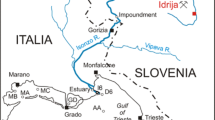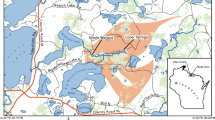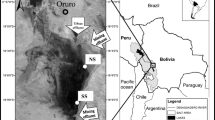Abstract
Microbial mercury (Hg) methylation and methylmercury (MeHg) degradation processes were examined using radiolabled model Hg compounds in San Francisco Bay-Delta surface sediments during three seasonal periods: late winter, spring, and fall. Strong seasonal and spatial differences were evident for both processes. MeHg production rates were positively correlated with microbial sulfate reduction rates during late winter only. MeHg production potential was also greatest during this period and decreased during spring and fall. This temporal trend was related both to an increase in gross MeHg degradation, driven by increasing temperature, and to a build-up in pore water sulfide and solid phase reduced sulfur driven by increased sulfate reduction during the warmer seasons. MeHg production decreased sharply with depth at two of three sites, both of which exhibited a corresponding increase in reduced sulfur compounds with depth. One site that was comparatively oxidized and alkaline exhibited little propensity for net MeHg production. These results support the hypothesis that net MeHg production is greatest when and where gross MeHg degradation rates are low and dissolved and solid phase reduced sulfur concentrations are low.
Similar content being viewed by others
Literature Cited
Alpers, C. N. andM. P. Hunerlach. 2000. Mercury contamination from historic mining in California. USGS Fact Sheet, FS-061-00. U.S. Geological Survey, Sacramento, California.
Arthur, J. F., M. D. Ball, andS. Y. Baughman. 1996. Summary of federal and state water project environmental impacts in the San Francisco Bay-Delta estuary, California, p. 445–496.In J. T. Hollibaugh (ed.), San Francisco Bay—The Ecosystem, Further Investigations into the Natural History of San Francisco Bay and Delta with Reference to the Influence of Man. Pacific Division of the American Association for the Advancement of Science, San Francisco, California.
Baldi, F., M. Pepi, andM. Filippelli. 1993. Methylmercury resistance inDesulfovibrio desulfuricans strains in relation to methylmercury degradation.Applied and Environmental Microbiology 59:2479–2485.
Benoit, J. M., C. C. Gilmour, andR. P. Mason. 2001a. The influence of sulfide on solid-phase mercury bioavailability for methylation by pure cultures ofDesulfobulbus propionicus (1pr3).Environmental Science and Technology 35:127–132.
Benoit, J. M., C. C. Gilmour, andR. P. Mason. 2001b. Aspects of bioavailability of mercury for methylation in pure cultures ofDesulfobulbus propionicus (1pr3).Applied and Environmental Microbiology 67:51–58.
Benoit, J. M., C. C. Gilmour, R. P. Mason, andA. Heyes. 1999. Sulfide controls on mercury speciation and bioavailability to methylating bacteria in sediment porewaters.Environmental Science and Technology 33:951–957.
Chen, Y., J. C. Bonzongo, andG. C. Miller. 1996. Levels of methylmercury and controlling factors in surface sediments of the Carson River system, Nevada.Environmental Pollution 92: 281–287.
Choi, S.-C. andR. Bartha. 1994. Environmental factors affecting mercury methylation in estuarine sediments.Bulletin of Environmental Contamination and Toxicology 53:805–812.
Cline, J. D. 1969. Spectrophotometric determination of hydrogen sulfide in natural waters.Limnology and Oceanography 14: 454–458.
Compeau, G. C. andR. Bartha. 1984. Methylation and demethylation of mercury under controlled redox, pH, and salinity conditions.Applied and Environmental Microbiology 48:1203–1207.
Compeau, G. C. andR. Bartha. 1985. Sulfate-reducing bacteria: Principal methylators of mercury in anoxic estuarine sediment.Applied and Environmental Microbiology 50:498–502.
Devereux, R., M. R. Winfrey, J. Winfrey, andD. A. Stahl. 1996. Depth profile of sulfate-reducing bacterial ribosomal RNA and mercury methylation in an estuarine sediment.FEMS Microbiology Ecology 20:23–31.
Dionex. 1992. Installation Instructions and Troubleshooting Guide for the IONPACo AG4A-SC Guard Column/IONPACo AS4A-SC Analytical Column. Document No. 034528. Dionex Corporation, Sunnyvale, California.
Domagalski, J. 1998. Occurrence and transport of total mercury and methyl mercury in the Sacramento River Basin, California.Journal of Geochemical Exploration 64:277–291.
Domagalski, J. 2001 Mercury and methylmercury in water and sediment of the Sacramento River Basin, California.Applied Geochemistry 16:1677–1691.
Gagnon, C., E. Pelletier, andA. Mucci. 1997. Behavior of anthropogenic mercury in coastal marine sediments.Marine Chemistry 59:159–176.
Gagnon, C., E. Pelletier, A. Mucci, andW. F. Fitzgerald. 1996. Diagenetic behavior of methylmercury in organic-rich coastal sediments.Limnology and Oceanography 41:428–434.
Gill, G. A. andK. W. Bruland. 1990. Mercury speciation in surface freshwater systems in California and other areas.Environmental Science and Technology 24:1392–1400.
Gill, G., M. Stephenson, K. Coale, C. Foe, andM. Marvin-DiPasquale. 2002. Conceptual model and working hypotheses of mercury cycling and transport in the Bay-Delta ecosystem and its tributaries. CALFED Bay-Delta Program, California Bay-Delta Authority. Sacramento, California. http://loer.tamug.tamu.edu/calfed/DraftReports.htm
Gilmour, C. C., E. A. Henry, andR. Mitchell. 1992. Sulfate stimulation of mercury methylation in freshwater sediments.Environmental Science and Technology 26:2281–2287.
Gilmour, C. C. andG. S. Riedel. 1995. Measurement of Hg methylation in sediments using high specific-activity Hg-203 and ambient incubation.Water Air and Soil Pollution 80:747–756.
Gilmour, C. C., G. S. Riedel, J. D. Coastes, and D. Lovley. 1996. Mercury methylation by iron (III)-reducing bacteria. Abstracts of the American Society for Microbiology 96th General Meeting, May 19–23, 1996, New Orleans, Louisiana. Abstract: (98) O-15:356.
Gilmour, C. C., G. S. Riedel, M. C. Ederington, J. T. Bell, J. M. Benoit, G. A. Gill, andM. C. Stordal. 1998. Methylmercury concentrations and production rates across a trophic gradient in the northern Everglades.Biogeochemistry 40:327–345.
Hoffman, D. J., H. M. Ohlendorf, C. M. Marn, andG. W. Pendleton. 1998. Association of mercury and selenium with altered glutathione metabolism and oxidative stress in diving ducks from the San Francisco Bay region, USA.Environmental Toxicology and Chemistry 17:167–172.
Hunerlach, M. P., J. J. Rytuba, andC. N. Alpers. 1999. Mercury contamination from hydraulic placer-gold mining in the Dutch Flat mining district, p. 179–189.In D. W. Morganwalp and H. T. Buxton (eds.), Contamination of Hydrologic Systems and Related Ecosystems, Volume 2; Section B—Mercury Contamination of Aquatic Ecosystems. Toxic Substance Hydrology Program, Water-Resources Investigation Report, 99-4018B. U.S. Geological Survey, West Trenton, New Jersey.
Jørgensen, B. B. 1978. A comparison of methods for the quantification of bacterial sulfate reduction in coastal marine sediments. 1. Measurement with radiotracer techniques.Geomicrobiology Journal 1:11–27.
King, J. K., J. E. Kostka, M. E. Frischer, andF. M. Saunders. 2000. Sulfate-reducing bacteria methylate mercury at variable rates in pure culture and in marine sediments.Applied and Environmental Microbiology 66:2430–2437.
King, J. K., J. E. Kostka, M. E. Frischer, F. M. Saunders, andR. A. Jahnke. 2001. A quantitative relationship that demonstrates mercury methylation rates in marine sediments are based on the community composition and activity of sulfate-reducing bacteria.Environmental Science and Technology 35: 2491–2496.
King, J. K., F. M. Saunders, R. F. Lee, andR. A. Jahnke. 1999. Coupling mercury methylation rates to sulfate reduction rates in marine sediments.Environmental Toxicology and Chemistry 18: 1362–1369.
Korthals, E. T. andM. R. Winfrey. 1987. Seasonal and spatial variations in mercury methylation and demethylation in an oligotrophic lake.Applied and Environmental Microbiology 53: 2397–2404.
Krabbenhoft, D. P., C. C. Gilmour, J. M. Benoit, C. L. Babiarz, A. W. Andren, andJ. P. Hurley. 1998. Methyl mercury dynamics in littoral sediments of a temperate seepage lake.Canadian Journal of Fisheries and Aquatic Sciences 55:835–844.
Macalady, J. L., E. E. Mack, D. C. Nelson, andK. M. Scow. 2000 Sediment microbial community structure and mercury methylation in mercury-polluted Clear Lake, California.Applied and Environmental Microbiology 66:1479–1488.
Marvin-DiPasquale, M., J. Agee, R. Bouse, andB. Jaffe. 2003. Microbial cycling of mercury in contaminated pelagic and wetland sediments of San Pablo Bay, California.Environmental Geology 43:260–267.
Marvin-DiPasquale, M., J. Agee, C. McGowan, R. S. Oremland, M. Thomas, D. Krabbenhoft, andC. Gilmour. 2000. Methylmercury degradation pathways: A comparison among three mercury-impacted ecosystems.Environmental Science and Technology 34:4908–4916.
Marvin-DiPasquale, M. C. andD. G. Capone. 1998. Benthic sulfate reduction along the Chesapeake Bay central channel. I. Spatial trends and controls.Marine Ecology Progress Series 168: 213–228.
Marvin-DiPasquale, M. C. andR. S. Oremland. 1998. Bacterial methylmercury degradation in Florida Everglades peat sediment.Environmental Science and Technology 32:2556–2563.
May, J. T., R. L. Hothem, C. N. Alpers, andM. A. Law. 2000. Mercury bioaccumulation in fish in a region affected by historic gold mining: The South Yuba River, Deer Creek, and Bear River Watersheds, California, 1999. Open-File Report, 00-367. U.S. Geological Survey, Sacramento, California.
Olson, B. H. andR. C. Cooper. 1976. Comparison of aerobic and anaerobic methylation of mercuric chloride by San Francisco Bay sediments.Water Research 10:113–116.
Oremland, R. S., C. W. Culbertson, andM. R. Winfrey. 1991. Methylmercury decomposition in sediments and bacterial cultures: Involvement of methanogens and sulfate reducers in oxidative demethylation.Applied and Environmental Microbiology 57:130–137.
Oremland, R. S., L. G. Miller, P. Dowdle, T. Connell, andT. Barkey. 1995. Methylmercury oxidative degradation potentials in contaminated and pristine sediments of the Carson River, Nevada.Applied and Environmental Microbiology 61:2745–2753.
Pak, K.-R. andR. Bartha. 1998. Mercury methylation by interspecies hydrogen and acetate transfer between sulfidogens and methanogens.Applied and Environmental Microbiology 64: 1987–1990.
Robinson, J. B. andO. H. Tuovinen. 1984. Mechanisms of microbial resistance and detoxification of mercury and organomercury compounds: Physiological, biochemical, and genetic analyses.Microbiology Reviews 48:95–124.
San Francisco Bay Regional Water Quality Control Board (SFBRWQCB). 1995. Contaminant levels in fish tissue from San Francisco Bay. Final report. San Francisco Bay Regional Water Quality Control Board, State Water Resources Control Board, and California Department of Fish and Game Marine Pollution Laboratory, San Francisco, California.
San Francisco Estuary Institute (SFEI). 1999. San Francisco Bay Regional Monitoring Program for Trace Substances, 1997 Annual Report. San Francisco Estuary Institute, Richmond, California.
Save San Francisco Bay Association (SSFBA). 1995. Fishing for food in San Francisco Bay. Save San Francisco Bay Association, Oakland, California.
Simenstad, C., J. Toft, H. Higgins, J. Cordell, M. Orr, P. Williams, L. Grimaldo, andZ. Hymanson. 2000. Sacramento/San Joaquin Delta Breached Levee Wetland Study (BREACH)—Preliminary Report. University of Washington, School of Fisheries, Seattle, Washington.
Slotton, D. G., T. H. Suchanek, andS. M. Ayers. 2000. Delta wetlands restoration and the mercury question: Year 2 findings of the CALFED UC Davis delta mercury study.IEP Newsletter 13:34–44.
Stordal, M. C. andG. A. Gill. 1995. Determination of mercury methylation rates using a205Hg radiotracer technique.Water Air and Soil Pollution 80:725–734.
Suchanek, T. H., P. J. Richerson, J. R. Flanders, D. C. Nelson, L. H. Mullen, L. L. Brister, andJ. C. Becker. 2000. Monitoring inter-annual variability reveals sources of mercury contamination in Clear Lake, California.Environmental Monitoring and Assessment 64:299–310.
Ullrich, S. M., T. W. Tanton, andS. A. Abdrashitova. 2001. Mercury in the aquatic environment: A review of factors affecting methylation.Critical Reviews in Environmental Science and Technology 31:241–293.
Ulrich, G. A., L. R. Krumholz, andJ. M. Suflita. 1997. A rapid and simple method for estimating sulfate reduction activity and quantifying inorganic sulfides.Applied and Environmental Microbiology 63:1627–1630.
Watras, C. J., N. S. Bloom, S. A. Claas, K. A. Morrison, C. C. Gilmour, andS. R. Craig. 1995. Methylmercury production in the anoxic hypolimnion of a dimictic seepage lake.Water Air and Soil Pollution 80:735–745.
Westrich, J. T. andR. A. Berner. 1984. The role of sedimentary organic matter in bacterial sulfate reduction: The G model tested.Limnology and Oceanography 29:236–249.
Winfrey, M. R. andJ. W. M. Rudd. 1990. Environmental factors affecting the formation of methylmercury in low pH lakes.Environmental Toxicology and Chemistry 9:853–869.
Yin, Y. J., H. E. Allen, Y. M. Li, C. P. Huang, andP. F. Sanders. 1996. Adsorption of mercury(II) by soil: Effects of pH, chloride, and organic matter.Journal of Environmental Quality 25:837–844.
Source of Unpublished Materials
Stevenson, M. Personal Communication. California Department of Fish and Game, Moss Landing, California.
Author information
Authors and Affiliations
Corresponding author
Rights and permissions
About this article
Cite this article
Marvin-DiPasquale, M., Agee, J.L. Microbial mercury cycling in sediments of the San Francisco Bay-Delta. Estuaries 26, 1517–1528 (2003). https://doi.org/10.1007/BF02803660
Received:
Revised:
Accepted:
Issue Date:
DOI: https://doi.org/10.1007/BF02803660




